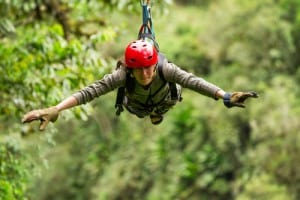Study Shows that Zip Line’s Growing Popularity Linked to Rise in Personal Injuries
 Thrill-seekers started the trend of flying through the air on a zip line, but in the past 16 years, the craze has swept the US. Now practically every summer camp, vacation hot spot, and theme park has a zip line. Many residential homes have “amateur” zip lines installed, as well. Unfortunately, because the high-flying trapeze-like activity has become so popular, there’s been a corresponding rise in personal injuries among users.
Thrill-seekers started the trend of flying through the air on a zip line, but in the past 16 years, the craze has swept the US. Now practically every summer camp, vacation hot spot, and theme park has a zip line. Many residential homes have “amateur” zip lines installed, as well. Unfortunately, because the high-flying trapeze-like activity has become so popular, there’s been a corresponding rise in personal injuries among users.
While this might seem obvious at first – zip lining is an activity that involves strapping oneself to a length of metal cord and propelling down the line as fast as possible – but an article recently published in the American Journal of Emergency Medicine suggests that zip lines are even more dangerous than is obvious to the average consumer. There were 17,000 personal injuries in the 16 years covered in the study, with most of those occurring in the past four years (the study looked at data ranging from 1997 to 2012). Worse, the researchers did not include data on deaths due to zip line accidents, of which there have been 6 across the United States in this year alone.
The study also revealed that the majority of accidents happen at commercial zip lines. About 30% of injuries occurred due to improperly installed zip lines at residential homes and farms, which implies user error; however, that leaves a shocking 70% of the recorded personal injuries at commercial courses, camps, and non-residential places that should take their customers’ safety into account.
“One of the things that really struck us about this study is how serious the injuries were. Almost 50 percent of them were fractures or broken bones, and over 10 percent actually had to be admitted to the hospital,” said Tracy Mehan of Nationwide Children’s Hospital in Columbus, Ohio, who led the research study.
“These are much higher and more serious injuries than we see with a lot of studies, and it shows us that this activity is much more like an adventure sport,” Mehan added.
Mehan said that the last several years have seen a spike in zip lines’ popularity. In 2001, there were only about 10 commercial zip lines in the US; by 2012, that number had risen to 200.
“The most common injury by far that we see are broken bones. That was almost 50 percent of our injuries. Other injuries can be bruises, sprains and strains, or concussions,” she said.
Another potential cause of users’ personal injury is the lack of specific, enforceable safety regulations. Although many commercial zip line companies have joined trade associations and voluntarily adopted safety standards like top speeds, length, and required helmets, those regulations vary too widely and are not enforceable by a government body. States are beginning to adopt basic safety regulations to protect residents, but there’s no uniform standard among those states, either.
Researchers said that DIY zip line kits should be avoided, but added that, due to the high rate of personal injuries among commercial zip line businesses, people who want the zip line experience should take a few basic steps to protect themselves. For example, they should check with the Better Business Bureau for accurate ratings and reviews to see if there have been any complaints about the company’s safety in the past. Ask the business about their safety standards and guidelines as well, and see if they are a member of any zip line trade associations or organizations. Finally, be sure to follow all the safety guidelines that instructors offer once on the course.
“I think a lot of families assume that if there is a zipline out there, that it is following industry safety standards and it’s being kept up and maintained in a way that is safe, but that’s not always the case,” Mehan said.
